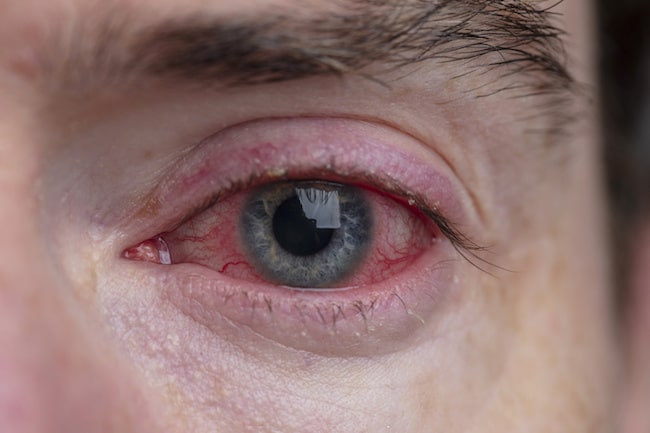We are all aware that welding is quite dangerous, and it is critical to wear the appropriate protective gear on the job, otherwise, you will be putting yourself, especially your eyes in grave danger.
When the heat becomes severe and sparks fly, it is critical to protect your body, especially your face and eyes.
And even if you take the necessary precautions, you may still have a welder’s eye, also known as arc-eye or flash burn, which is an inflammation of the cornea induced by UV light from the welding arc.
Arc-eye symptoms usually occur many hours after exposure, when the eyes become red, watery, and stinging. It is a painful experience and you should try to avoid it as much as possible.
If not treated properly, the welder’s eye can last up to three or more days. Your eye cornea takes two days to heal, but may fail to heal if it is severely injured. If the flash burn persists, get medical attention before both eyes are impacted which will eventually result in visual loss.
It is a serious injury which needs immediate attention by a professional.
But why is it called a welder’s eye?
A flash burn is an excruciatingly painful injury in the cornea, which is the transparent tissue that covers the front of the eye. When you are exposed to strong ultraviolet (UV) light, you will get a flash burn.
All sorts of UV radiation can cause it, although welding torches are the most prevalent source. That’s why it’s also known as a welder’s eye.
What causes a welder’s eye?
A welder’s eye is usually caused by being exposed to too much sparks and light in the welding industry.
When the eye is exposed to strong welding light without Personal Protective Equipment (PPE), the cornea is destroyed, putting the pupil at risk and causing immediate symptoms such as eye discomfort, burning, reddening, clouding, and so on.
Welder’s eye is quite like sunburn, but for the eyes. They might affect one or both eyes simultaneously.
If they are not treated or continue to put too much strain on their eyes, they may develop an infection and infections can be quite dangerous and, if not treated promptly, can result in visual loss.
What are the symptoms of welder’s eye?
The following are the most prevalent symptoms of a welding flash burn:
-
-
- Watery eyes.
- Sensitivity to light.
- Vision becomes hazy.
- Irritation of the eyes.
- Pain ranging from severe to minor.
-
Symptoms develop very immediately after exposure. Most of the time, the symptoms emerge immediately after the eyes are exposed to UV radiation.
One of the earliest symptoms is sudden eye discomfort, followed by twitching of the eyelids, irritation and swelling.
The eyes may also become red and watery and the skin surrounding the eyes might become puffy and reddish in rare circumstances.
Eyesight is sometimes compromised, and haziness and cloudiness may be felt since these are some of the most prevalent early signs of a welder’s eye. These symptoms may occur depending on how long a welder’s eye lasts.
The severity of a flash burn is determined by several factors, including the individual’s distance from the UV source, the length of time the eyes were exposed to the light source, and the angle at which the light source was viewed. These variables will decide how long the welder’s eye lasts.
Moreover, people who operate frequently with a welder’s flame should be aware that this form of continuous exposure can cause cataracts, which can lead to visual loss.
As a result, we cannot emphasise enough the significance of using personal eye protection.
What to do if you have a welder’s eye symptom?
The first thing a person should do after being exposed to UV radiation is visit an ophthalmologist. It’s advisable not to wait and to consult a doctor as soon as they notice any symptoms.
1.) Get a doctor’s opinion
It is critical to have a specialist examine the eyes since damage can occur in a variety of ways. The doctor will prescribe an antibiotic to prevent more infections.
If the cornea is injured during the procedure, the doctor will administer dilating fluids and padded bandages to the patient. These will aid in the healing process.
Also, always remember to go for your follow ups with the doctor. It is extremely important.
2.) Use cool packs- Cool packs are particularly efficient in providing symptomatic relief and can be put over the affected-eye dressing to help reduce the burning sensation. An ice pack should be used in moderation, no more than three to four times a day.
3.) Dressing- The greatest technique to assist the eyes relax and recuperate is to use eye-dressing. This is when the doctor applies a special cushioned bandage to the eyes, allowing them to relax and recover correctly.
Because some of the usual symptoms of a flash burn are eye irritation that leads to the sense of continual eye rubbing, which can slow down the healing process, the affected eye should be covered with padded dressing to guard from unnecessary light exposure and eye-rubbing.
4.) Antibiotics and eye drops- A medical professional may prescribe the use of antibiotics in the form of ointment or drops to be used at home which will help in reducing the development of an eye infection.
It is highly advised to follow all advice given by the medical professional on how many times the antibiotic medicine should be used and driving may be advised against by the doctor as well.
Here are some tips on how to take care of yourself at home if you’re diagnosed with a welder’s eye?
1.) Do not drive, let your eyes heal and it is also extremely dangerous for you and others around you if you drive.
2.) Make sure you wash your hands before you put drops on your eyes so that no foreign particles can enter and cause infection.
3.) Avoid using contact lenses until your eyes have healed.
4.) If your eyes are light sensitive, wear sunglasses as it will also protect your eyes and help heal faster.
5.) To alleviate any irritation in your eyes or if you’re suffering from dry eyes, use artificial tears or lubricants.
6.) It is critical to follow your doctor’s advice and return for a check-up.
Is there any way you can prevent a welder’s eye?
Other light sources can cause a welder’s eye in rare instances. Individuals working in the welding sector, on the other hand, can take the following preventive precautions to safeguard their eyes, as prevention is the best method:
1.) Purchasing an eye goggle that meets Health and Safety regulations and completely covers the eyes.
2.) When doing welding work, coated safety eye goggles should be used combined with a welder’s mask to protect the cornea from UV radiation.
3.) If a person is using sunglasses to avoid a flash burn, the sunglasses should shield them from UVB and UV rays.
4.) When purchasing sunglasses, the labels should be examined to determine the level of eye protection provided.
Some home remedies you can try for welder’s eye
We strongly recommend you to visit the doctor immediately if you have any welder’s eye symptoms. But sometimes, doctors aren’t available and you need immediate relief from pain. So there are some first aids you can do at home-
1.) Milk
Milk is said to be the safest for skin care and eye care. It includes enzymes that decrease inflammation in the eyes.
• Boil milk in a clean saucepan until it reaches its boiling point.
• Allow the milk to cool down.
• Using soft cotton, insert the cotton ball into the milk and apply the milk to the eyes.
2.) Cucumber slices
Cucumber is valued for its cooling properties. It relieves eye swelling and reddening because it contains a lot of water, which works exactly like ice. Cucumber also keeps the eyes from drying out and smoothes down dry skin.
3.) Vicks Vaporub ointment
Vicks Vaporub is often used by welders to treat the welder’s eye. The ointment works by causing your eyes to get obscured with tears.
To use the ointment, apply it around the eye region, but avoid getting it in direct contact with the eyes.
4.) Using sliced raw potato
Potatoes contain water, which moisturises the dry skin around the eyes. It also has a cooling effect, which minimises eye swelling and reddening.
Simply slice the potato and soak it in water. Place them in the refrigerator and apply them to the afflicted region after laying up.
To conclude, when the eyes are subjected to extreme UV light, flash burn develops which can be highly painful. Welders are most likely to be affected since their profession involves dealing with machinery that generates UV radiation and heat.
Welder’s flash is usually treated and recovers on its own. Nonetheless, personal protective eyewear is required for all welders on the job.








